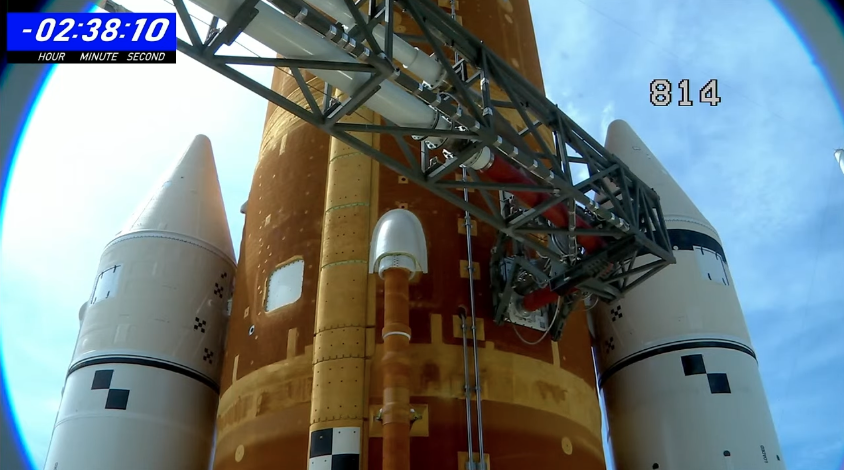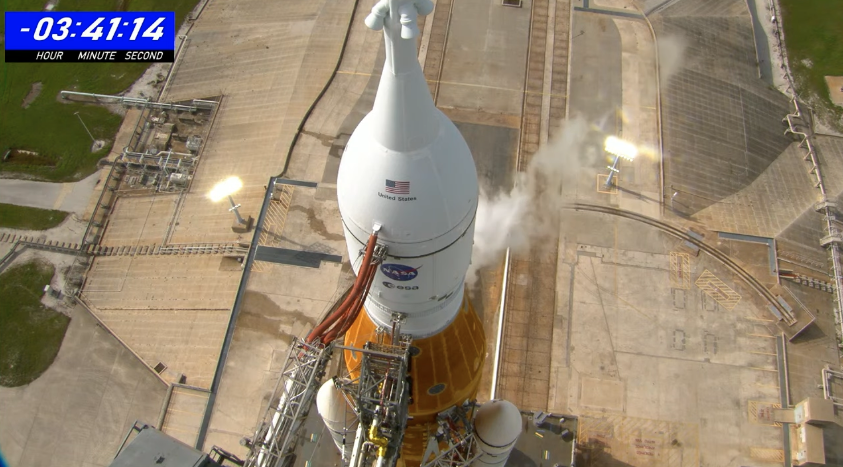Updates: NASA scrubs major Artemis I mission a second time at KSC
Space is important to us and that’s why we're working to bring you top coverage of the industry and Florida launches. Journalism like this takes time and resources. Please support it with a subscription here.
---
Update: NASA has called off the Saturday, Sept. 3, Artemis I launch attempt due to a hydrogen leak. The next opportunity to fly to the moon won't open until Sept. 19, but officials say a slip to October is likely considering the amount of work that needs to be done. Stay tuned at floridatoday.com/space.
---
Follow live as NASA targets 2:17 p.m. EDT Saturday, Sept. 3, for the launch of its massive Space Launch System rocket on a mission to the moon known as Artemis I.
The 322-foot rocket and Orion capsule have a two-hour window to fly from Kennedy Space Center in Florida, where weather conditions are expected to be 60% "go" at liftoff. If they need it, teams have a two-hour window to fly from pad 39B.
If it takes off on time, this mission will take Orion on a 38-day mission to the moon and back. There is no crew aboard.
Follow live updates below (manual refresh required; follow this link for more frequent, real-time updates).
Briefing: SLS won't fly for several weeks
NASA officials on Saturday said teams were planning to roll the 322-foot SLS rocket back to the Vehicle Assembly Building for repairs and recertifications, likely meaning a delay for the Artemis I flight to late this month but most likely sometime in October.
A 2:17 p.m. EDT Saturday, Sept. 3, attempt was scrubbed primarily due to a large hydrogen leak at pad 39B. The issue was severe enough to call off all remaining launch opportunities in this Earth-to-moon window that closes after Tuesday, Sept. 6.
SLS uses liquid oxygen and liquid hydrogen as propellants. Saturday's attempt saw the liquid oxygen tank 100% filled, but the hydrogen tank only hit about 10% before the scrub was called.
"This was not a manageable leak," Artemis I Mission Manager Mike Sarafin told reporters Saturday.
Another roughly two-week launch window opens Sept. 19. While officials said that timeline is possible, it appears more likely that Artemis I won't be ready to fly again until yet another two-week opportunity opens Oct. 17.
Rolling back to the VAB for repairs, certifications, and preparations for another rollout to pad 39B would take "several weeks," Sarafin said. But he cautioned that it was too early to rule out late September or early October.
One of the main reasons for a VAB rollback is the termination system, which destroys the rocket in case it veers off course or sees some other emergency issue. It needs to be re-certified – an operation that can only be done in the VAB – every 25 days, but officials said the Space Force might be willing to grant an extension. The military branch is in charge of public safety during launches, so it's their call.
Officials also said the hydrogen leak could potentially be fixed at the pad.
But as it stands, the Space Force has not granted an extension and the leak, located in the lower portion of the 322-foot rocket, will most likely need to be fixed in the VAB. More details are expected early next week.
Artemis I scrub!
SCRUB! No Artemis I launch today primarily due to the hydrogen leak issue. There are opportunities available Monday and Tuesday, but will depend on a fix. Stay tuned for more details.
Launch director wants more time

11:10 a.m. EDT: Launch Director Charlie Blackwell-Thompson, who was presented with a recommendation to scrub today's attempt a few minutes ago, said she would like some more time to confer with teams before officially waving off today's flight. Stay tuned.
Scrub recommendation presented to LD
10:55 a.m. EDT: The launch team is recommending a "no-go" status for today's Artemis I liftoff. That will now go to the launch director, who will most likely approve that. Pretty safe to say today will be a scrub.
To be clear, it's safe to say today's launch has been scrubbed due to the hydrogen leak issue. Just waiting for Launch Director Charlie Blackwell-Thompson to make the official call based on meetings with her team.
Fix not effective
10:28 a.m. EDT: NASA reports a third attempt at fixing the ongoing hydrogen leak didn't work. Teams will meet and discuss next options, but it's safe to say things aren't looking good.
Liftoff still targeting 2:17 p.m. EDT, but you can expect this to shift to later in the two-hour window – or we see a scrub. Stay tuned.
Moving to hydrogen fill again
10:15 a.m. EDT: After letting the leaky line warm up, NASA is again starting to flow supercooled hydrogen into the SLS rocket. We'll see if the fix holds. Otherwise, the LH2 loading process is way behind as you can tell from the latest fill percentages:
Liquid oxygen (LOX): 100% filled
Liquid hydrogen (LH2): 10% filled
Teams have new plan

10 a.m. EDT: In an effort to fix a hydrogen line leak, NASA will let it warm up before pushing through supercooled liquid hydrogen again. Managers hope the stop-go process will help reseat the connection and resolve the issue.
Liquid oxygen (LOX): 99% filled and topping
Liquid hydrogen (LH2): 9% filled and holding
LH2 leak still detected
9:35 a.m. EDT: Attempts to fix a hydrogen leak impacting today’s Artemis I launch haven’t worked, according to the latest NASA update. Most recently, teams pressurized a line with helium in an effort to reseat it, but the leak is still being detected. Managers will confer.
Liquid oxygen (LOX): 89% filled
Liquid hydrogen (LH2): 10% filled
Hydrogen flowing again
9:20 a.m. EDT: The leaky hydrogen line leading to the SLS rocket's core stage is now flowing with propellant again, but at the slow-fill rate. Teams will monitor the speed and status of fill to make sure the attempt at fixing the problem holds.
Liquid oxygen (LOX): 75% filled
Liquid hydrogen (LH2): Still holding 8% filled
Hydrogen flow back on
9:10 a.m. EDT: NASA says the use of helium to re-pressurize the hydrogen line is done. Will start flowing hydrogen again at the slow-fill rate. Latest status:
Liquid oxygen (LOX): 71% filled
Liquid hydrogen (LH2): Holding at 8% filled
Hydrogen flow stopped again
9:05 a.m. EDT: Teams have stopped flowing hydrogen into the core stage again due to the previous leak. They've loaded helium into the line to pressurize it in an effort to "reseat" it; if that works, they'll again move from a slow-fill to fast-fill process.
Liquid oxygen (LOX): 68% filled
Liquid hydrogen (LH2): 8% filled
Hydrogen still flowing
8:45 a.m. EDT: Teams at KSC's Launch Control Center are still seeing hydrogen flowing into the core stage properly, but at the tedious "slow fill" rate. They're keeping an eye on the fix before moving to "fast fill," which should speed up the process dramatically and hopefully make up for lost time. Current fueling status:
Liquid oxygen (LOX): 53% filled
Liquid hydrogen (LH2): 7% filled
Artemis traffic: update
8:30 a.m. EDT: Much less traffic today so far compared to Monday's attempt. Example: Starting at 4:20 a.m. Monday, it took our reporter 1 hour 45 minutes to creep 5.9 miles to the KSC checkpoint on North Courtenay. Today, he drove directly to the checkpoint with no delays.
Hydrogen flowing again
8:15 a.m. EDT: Teams are seeing liquid hydrogen flowing into the Space Launch System rocket's core stage again, though at a much slower rate than usual. Good sign that the issue is resolved. Current status:
Liquid oxygen: 40% filled
Liquid hydrogen: 4% filled
Teams propose hydrogen solution
7:50 a.m. EDT: NASA teams at Kennedy Space Center working through a supercooled liquid hydrogen loading issue have agreed on a path forward: one of the umbilicals leading to the rocket will be allowed to warm up, then slowly chilled again. This will allow it to "reseat," potentially resolving the issue. SLS uses a mixture of liquid hydrogen and oxygen.
Fuel loading pause at KSC
7:25 a.m. EDT: Teams have paused loading hydrogen into the Space Launch System rocket due to a leak detected in the engine cavity. Hydrogen, along with liquid oxygen, is one of two main propellants used by the 322-foot rocket. Stay tuned.
Luckily, teams today have a two-hour window to fly, so there's plenty of time to resolve the leak issue. Window still opens at 2:17 p.m. EDT.
'Go' to start fueling at KSC
6 a.m. EDT: NASA teams at Kennedy Space Center's Launch Control Center have polled "go" to start the fueling process for the Space Launch System rocket this morning. This sets mission managers on a path toward an on-time liftoff at 2:17 p.m. EDT.
Contact Emre Kelly at aekelly@floridatoday.com or 321-242-3715. Follow him on Twitter, Facebook and Instagram at @EmreKelly.
This article originally appeared on Florida Today: Updates: NASA scrubs major Artemis I mission a second time at KSC

